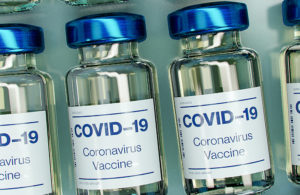 Today, the White House COVID-19 response team held a press briefing to discuss a range of themes. Andy Slavitt, Senior White House advisor, share information on the current pace of vaccination. CDC Director Dr. Rochelle Walensky shared information on the current spread of COVID-19 and its impact on U.S. life expectancy. Dr. Anthony Fauci, the nation’s top infectious disease expert, was on hand to discuss the potential vaccination of children. Here are five highlights from the briefing:
Today, the White House COVID-19 response team held a press briefing to discuss a range of themes. Andy Slavitt, Senior White House advisor, share information on the current pace of vaccination. CDC Director Dr. Rochelle Walensky shared information on the current spread of COVID-19 and its impact on U.S. life expectancy. Dr. Anthony Fauci, the nation’s top infectious disease expert, was on hand to discuss the potential vaccination of children. Here are five highlights from the briefing:
1. Freezing weather has curbed COVID-19 vaccine distribution
All 50 states have been affected by COVID-19 vaccine shortages stemming from severe weather afflicting much of the U.S. “We have a backlog of about 6 million doses,” said Andy Slavitt, Senior White House advisor, in a press briefing.
U.S. vaccine distribution partners FedEx, UPS and McKesson have struggled to package and ship vaccine kits and related supplies. Many of the firm’s workers have struggled with road closures impacting distribution and shipping hubs.
Additionally, more than 2000 of the country’s vaccine sites are based in areas with power outages, which has forced them to stop administering doses.
The U.S. government is working with partners to “clear this backlog,” Slavitt said. Some 1.4 million vaccine doses are already in transit, and “we anticipate that all the backlog doses will be delivered within the next week.”
2. The U.S. is establishing new vaccination sites
The federal government will soon open five new vaccination centers. For will be in Florida and the other in Pennsylvania. “These sites will have the capacity to vaccinate a total of 12,000 individuals per day,” Slavitt said.
In choosing the sites, the government used criteria intended to promote equitable vaccine access while prioritizing vaccination of individuals deemed most vulnerable according to CDC criteria.
“The federal government will be deploying teams immediately to work hand in hand with state and local jurisdictions to get these sites set up, and we expect all to be up and running in the next two weeks,” Slavitt said.
3. COVID-19 cases in the U.S. continue to fall
While inclement weather has slowed testing, data suggest that COVID-19 levels in the U.S. have fallen considerably in recent weeks. “We continue to see a five week decline in COVID cases with cases decreasing 69% in the seven-day average since hitting a peak on January 11,” said CDC Director Dr. Rochelle Walensky. “The current seven-day average of approximately 77,000 cases is the lowest reported since the end of October, but still higher than the height of last summer’s peak.”
COVID-19-related hospital admissions have also fallen 56% between January 9 and February 16. Deaths have declined more modestly recently.
4. The pandemic is shortening life expectancy in the U.S.
A recent CDC report concluded that the provisional life expectancy in the first half of 2020 dipped by about one year compared to 2019. “The declines in life expectancy were most pronounced in certain racial and ethnic minority groups,” Walensky said. Non-Hispanic Black persons saw life expectancy drop 2.7 years while Hispanics saw a reduction of 1.9 years.
“I think we’re going to have a lot of work to do in this country over the years ahead to try and make up the losses that we’ve seen with this pandemic,” Walensky said.
The latest data underscores that vaccines are safe
More than 41 million people in the U.S. have received at least one dose of the COVID-19 vaccine. A substantial portion of the population, however, is vaccine-hesitant.
To address that challenge, CDC plans to release a study on the subject of COVID-19 vaccine safety monitoring in the S.S. from Dec. 14 through Jan. 13.
Walensky previewed data from the research, which found that about seven in 10 vaccine recipients have pain at the injection site. One-third reported fatigue, and 30% reported headaches. “These are common with most vaccines and they typically resolved within a day or two of vaccination,” Walensky said.
Vaccine side effects are more pronounced after the second dose. “It’s important to know that about half the people don’t feel very well after getting their second dose,” Walensky said. “This should not deter you from getting your second dose but you need to have a light day of activity after getting vaccinated.”
Reports of severe allergic reactions, including anaphylaxis, were relatively rare. “There were 4.5 cases of anaphylaxis per one million doses given [from Dec. 14 to Jan. 13] — a rate similar to what we’ve seen in other commonly used vaccines,” Walensky said.
While some 113 vaccine recipients have died, the available data suggests they were unrelated to the vaccine, according to Walensky. Nearly two-thirds of those deaths involved long-term-care residents. “the death rate in this population, though truly sad and unfortunate, was consistent with the expected background death rate in this demographic,” Walensky said.
5. COVID-19 vaccine research on children is underway
Vaccine developers are conducting COVID-19 vaccine research on children. While the vaccine from Pfizer (NYSE:PFE) and BioNTech (NSDQ:BNTX) is currently indicated for people as young as 16, it is now studying it in children as young as 12. In April, the companies will begin testing the vaccine in children from five or six to 12 years old.
Moderna (NSDQ:MRNA) i is doing similar testing on children. Early data on high-school-aged children could appear later this year, while data on younger children could be available in the first quarter of 2022 or later, according to Dr. Anthony Fauci.